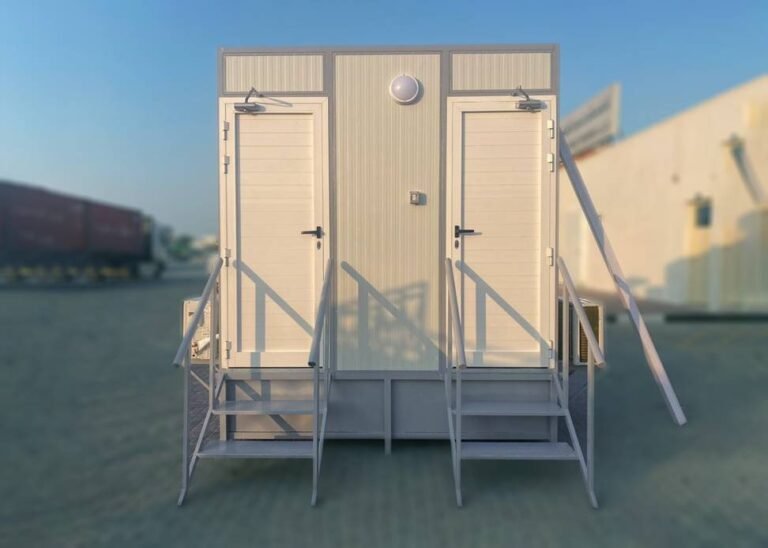
Meeting the Modern Sanitation Challenge
In today’s rapidly urbanizing world, the demand for efficient, hygienic, and sustainable sanitation solutions has never been greater. Traditional toilet facilities often fall short in addressing the needs of growing populations, remote locations, and temporary setups. Enter prefabricated toilets—a game-changing innovation that’s transforming how we think about public and private sanitation.
Prefabricated Toilets
Prefabricated toilets, commonly known as prefab toilets, are sanitation units manufactured off-site in controlled environments and then transported to their intended locations. These units are constructed using durable materials like fiber-reinforced plastic (FRP), polyvinyl chloride (PVC), and high-density polyethylene (HDPE), ensuring longevity and resistance to harsh environmental conditions.
Advantages Over Traditional Alternatives
- Rapid Deployment: Prefab toilets can be installed quickly, making them ideal for emergency situations, construction sites, and events.
- Cost-Effective: Manufacturing in bulk reduces per-unit costs, offering a budget-friendly alternative to traditional construction.
- Quality Control: Factory production ensures consistent quality and adherence to sanitation standards.
- Minimal Site Disruption: Off-site construction reduces on-site labor and associated disturbances.
Versatility and Customization
Various Uses and Applications
Prefab toilets are versatile and can be utilized in diverse settings:
- Construction Sites: Providing essential facilities for workers.
- Public Events: Offering sanitation solutions for festivals, concerts, and sports events.
- Remote Areas: Serving communities lacking traditional infrastructure.
- Disaster Relief: Rapid deployment in areas affected by natural calamities.
Tailoring to Specific Needs
Customization options include:
- Size and Layout: From single units to multi-stall complexes.
- Accessibility Features: Incorporating ramps and handrails for disabled users.
- Aesthetic Design: Aligning with the visual theme of the location.
- Technological Additions: Integrating solar panels, ventilation systems, and water-saving fixtures.
Cost-Effectiveness and Eco-Friendly Nature
Reduced Costs
Prefab toilets offer significant cost savings:
- Lower Construction Costs: Mass production reduces material and labor expenses.
- Maintenance Efficiency: Durable materials decrease the frequency and cost of repairs.
- Operational Savings: Features like waterless urinals and composting systems reduce utility bills.
Sustainability
Environmental benefits include:
- Reduced Water Usage: Innovative flushing systems minimize water consumption.
- Recyclable Materials: Use of eco-friendly materials like recycled plastics.
- Waste Management: Integration of bio-digesters for efficient waste processing.

Ease of Implementation
Simple Installation
The plug-and-play nature of prefab toilets allows for swift setup with minimal technical expertise. This is particularly beneficial in scenarios requiring immediate sanitation solutions.
Space-Saving Benefits
Compact designs ensure that these units occupy minimal space, making them suitable for areas with spatial constraints
Mobility and Flexibility
Relocation or Adaptability
Prefab toilets can be easily transported and reinstalled at different locations, offering unparalleled flexibility for temporary or changing needs.
Temporary vs. Permanent Solutions
While ideal for short-term requirements, prefab toilets can also serve as permanent installations, especially in areas where traditional construction is impractical.
Safety and Durability
Structural Integrity
Constructed with robust materials, prefab toilets are designed to withstand heavy usage and adverse weather conditions, ensuring long-term reliability.
Resistance to Environmental Factors
Features like UV-resistant coatings and corrosion-proof materials enhance durability, making them suitable for diverse climates.
Innovations and Future Prospects
Technological Advancements
The future of prefab toilets is bright, with innovations such as:
- Smart Monitoring Systems: Real-time tracking of usage and maintenance needs.
- Energy-Efficient Features: Integration of solar panels and LED lighting.
- Advanced Waste Treatment: Enhanced bio-digesters and composting technologies.
Conclusion
Prefabricated toilets represent a significant leap forward in addressing the world’s sanitation challenges. Their versatility, cost-effectiveness, and sustainability make them an indispensable component of modern infrastructure. As technology advances and awareness grows, prefab toilets will undoubtedly become a standard in both temporary and permanent sanitation solutions.
FAQs
Q1: What materials are commonly used in prefab toilets?
A: Materials like FRP, PVC, and HDPE are commonly used due to their durability and resistance to environmental factors.
Q2: Can prefab toilets be customized for specific needs?
A: Yes, they can be tailored in terms of size, design, accessibility features, and technological integrations.
Q3: How do prefab toilets contribute to environmental sustainability?
A: They reduce water usage, utilize recyclable materials, and can incorporate waste treatment systems like bio-digesters.
Q4: Are prefab toilets suitable for permanent installations?
A: Absolutely. While they are ideal for temporary setups, their durability and design make them suitable for long-term use as well.
Q5: What maintenance is required for prefab toilets?
A: Regular cleaning and periodic servicing of waste treatment systems are essential to maintain hygiene and functionality.
